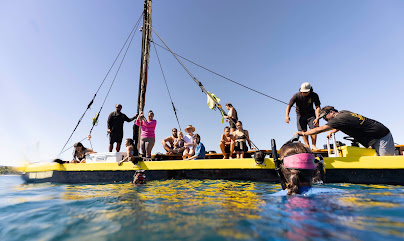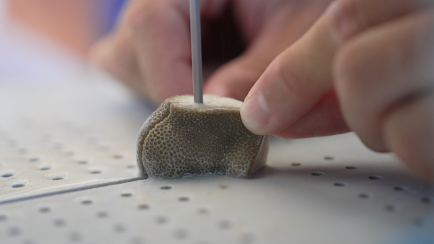 |
| Ramona Okumura reported herself on the move to cross into Egypt after being trapped in the Gaza war for three weeks. Photo from Okumua family |
 |
| Close up of Porites lobata coral planted in Kahuwai Bay. Photo by Liquid Cosmos Divers 2 |
At the event, project partners planted ko'a in Kahuwai Bay, within the ahupuaʻa of Kaʻūpūlehu. TNC divers and Native Hawaiian lineal descendants of Kaʻūpūlehu collected pieces of ko'a within the Bay that had broken off during recent high swells and would have otherwise died. Ko'a pieces were brought to shore on waʻa Kinikini, a double-hulled canoe. Together, the team used specialized saws to cut the collected pieces into 1-inch fragments. Scuba divers transported the pieces back into the Bay and affixed them to the reef with epoxy, while snorkelers watched from above. Ko'a pieces were planted in clusters, enabling them to grow together into a colony more quickly. All work with ko'a is being conducted under a Special Activities Permit with the State Division of Aquatic Resources.
"We are honored to support and work with the KMLAC and other communities who embrace their
ancestral relationships to these places and perpetuate their cultural heritage along this coastline," says Rebecca Most, TNC Marine Program Director on the Island of Hawaiʻi. "Together, we are building coral reefs' ability to withstand the growing effects of the climate crisis."
Coral reef health across the islands continues to decline, but reef restoration can build their resilience and help them recover. Scientists estimate that live coral cover on some Hawai'i reefs has declined by 60% over the past 40 years, due in part to overfishing and pollutants washing in from land. The climate crisis exacerbates this decline, with three
 | |
| KMLAC members and other team members on the wa'a Kinikini in Kahuwai Bay Coral Restoration project. Photo by Liquid Cosmos Divers - 2 |
Kaʻūpūlehu was prioritized for restoration through a statewide planning process because it is a healthy, well-managed area where restoration is likely to succeed. Kahuwai Bay has few land-based pollution sources and is in a sheltered location that is less likely to experience severe storm damage. The Bay is also within the Kaʻūpūlehu Marine Reserve, a 10-year rest area established in 2016 along 3.6 miles of coastline to give fish populations an opportunity to replenish. TNC surveys within the rest area showed a 612% increase in prime spawners (fish that lay the most eggs) in just four years.
"Impacts on coral over the past decade have been devastating," says TNC Trustee and KMLAC member Vern Yamanaka. "As stewards of Kaʻūpūlehu, it is our kuleana and obligation to do what we can to protect coral, the basis of life in our nearshore waters. We need healthy coral reefs to maintain the marine life we are working to preserve, protect and sustainably manage, and this project will help us do that."
 |
| A piece of Porites lobata coral being fragmented. Photo from Ryzone Media |
This event is the first step in determining the best restoration method for ko'a species that surround the Island of Hawaiʻi. Next steps include planting whole pieces of broken corals and installing an in-water nursery table to grow corals from fragments, which will then be out planted. During the next year, the KMLAC-TNC team will monitor the growth rates and health of the planted ko'a to evaluate which method of planting—whole pieces, fragments or nursery-grown fragments—helps ko'a grow best.
"Restoration is an important tool in the fight against reef decline, but its adoption in Hawai'i and the Pacific is relatively novel," says Joe Pollock, Ph.D., TNC Senior Coral Reef Resilience Scientist. "By anchoring this project in science and culture while prioritizing learning and knowledge sharing, we can enhance local reef benefits while disseminating the insights needed to successfully scale up reef restoration throughout Hawai'i and beyond."
The Kaʻūpūlehu Marine Life Advisory Committee (KMLAC) is a collaborative effort between the Native Hawaiian lineal descendants of Ka'ūpūlehu, representatives from Kamehameha Schools, the Office of Hawaiian Affairs, lessees within the ahupuaʻa, resource managers, local non-governmental organizations, and state agency staff. The KMLAC is devoted to "perpetuating the legacy of our forebearers to protect, tend, and restore the biocultural resources of Ka'ūpūlehu."See https://www.facebook.com/KMLAC/ https://www.instagram.com/kaupulehu.mlac/
To read comments, add your own, and like this story, see facebook.com/kaucalendar. See latest print edition at kaucalendar.com, in the mail and on stands.
HAWAI'I ISLAND POLICE HAVE LOCATED 40-year old Shawna Tidwell of Ocean View, who was wanted for questioning regarding an ongoing criminal investigation. The Hawaii Police Department would like to thank the public’s assistance in locating Tidwell who was located in the Hawaii Ocean View Estates subdivision at 9:00 a.m. on Tuesday, October 31, 2023.
To read comments, add your own, and like this story, see facebook.com/kaucalendar. See latest print edition at kaucalendar.com, in the mail and on stands.
 |
| Uēkahuna summit tiltmeter shows infaltion and defation. USGS photo M. Cappos |
Elevated seismicity (a seismic swarm) associated with an intrusion beneath the south-southwest region of Kīlauea’s summit began in early October. Since then, swarm activity has varied, with the greatest number of earthquakes occurring on October 4-6, 16-18, 21-23, and 26-29. Over the past 24 hours, swarm activity continued to slightly increase, with approximately 127 earthquakes recorded in Kīlauea’s summit region, an increase from 74 over the previous 24 hours. Most of the earthquakes related to this unrest have been smaller than magnitude-2 and have occurred at depths of around 1–3 km (0.6–2 mi) below the Uēkahuna summit tiltmet hours, with minor deflation that transitioned to minor inflation last night. The Sand Hill tiltmeter, located southwest of the caldera, has been mostly stable over the past 24 hours, and continues to record gradual yet sustained uplift. Overall, inflation at the summit of Kīlauea remains high and has surpassed the level seen just before the most recent eruption on September 10. However, the current rate of inflation in the region has diminished significantly since October 4-6.
Sulfur dioxide (SO2) emission rates remain low and were measured at a rate of about 100 tonnes per day on October 19.
It is unclear if unrest in Kīlauea summit region will continue and it is not possible to say with certainty if activity will lead to an eruption; activity may remain below the ground surface. However, an eruption remains possible, most likely in Kīlauea’s summit region inside of Hawai‘i Volcanoes National Park and away from infrastructure. Similar patterns of earthquake activity and ground deformation occurred to the south of the caldera prior to the September and June 2023 eruptions in Kīlauea summit caldera (in Halemaʻumaʻu crater and on the downdropped block). Volcanic gas emissions pose the greatest hazard to areas downwind of Kīlauea’s summit.
There is currently no sign of an imminent eruption and increasing inflation and earthquake activity (heightened unrest) are expected to precede an eruption. During periods of heightened unrest prior to recent eruptions at Kīlauea summit, signs of imminent eruption did not appear until 1-2 hours before lava reached the surface. The summit of Kīlauea remains at a high level of inflation and eruptive activity is possible in the coming weeks or months. HVO scientists will continue to monitor Kīlauea volcano closely and will issue additional messages as warranted by changing activity.
NATIVE AND NON- NATIVE TREES WILL BE GIVEN AWAY IN OCEAN VIEW THIS SATURDAY, Nov. 4 from 8:30 a.m. to noon, as long as trees last. The location is
next to Malama Market. West Hawaii Master Gardeners is hosting its third Hawaii Arbor Day event. Quantities will be limited on a per-family basis depending on species. Tree planting guides will be available. Master Gardeners will be present to answer gardening questions.
Also, free seeds are available from the WHMG Free Seed Library.


See www.hawaiiwildfire.org/cwpp-resources and state Department of Land & Natural Resources website: dlnr.hawaii.gov/forestry/fire/community-risk-reduction/community-wildfire-protection-plans/.








